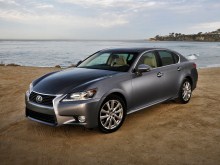Characteristics Lexus GS.
Technical characteristics of Lexus GS: Power, fuel consumption 100 km, weight (weight), road clearance (clearance), radius of turning, type of transmission and brakes, body sizes and tires.
GS Characteristics since 2012
| Modification |
Power, kW (hp) / about |
Fuel consumption (medium), l / 100 km |
Weight (weight), kg |
| 250 |
154(206)/6400 |
7.4 |
1680 |
| 350 AWD. |
226(303)/6200 |
19.6 |
1755 |
| 350 RWD. |
226(303)/6200 |
21.4 |
1680 |
| 460 |
255(342)/6200 |
19.6 |
1740 |
| 450h. |
|
5.3 |
|
GS Characteristics since 2008
| Modification |
Power, kW (hp) / about |
Fuel consumption (medium), l / 100 km |
Weight (weight), kg |
| 450h. |
253(340)/6400 |
7.9 |
1875 |
| 300 |
183(249)/6200 |
9.8 |
1695 |
| 350 |
226(303)/6200 |
10.7 |
1721 |
| 460 |
255(342)/6200 |
11.8 |
1789 |
| 3.0 AT. |
(249)/6200 |
9.5 |
1695 |
| 3.5 AT AWD. |
(307)/6400 |
10.1 |
1830 |
| 3.5 CVT. |
(296)/6400 |
7.6 |
1940 |
| 4.6 AT. |
(347)/6400 |
11 |
1810 |
Characteristics GS 2005 - 2008
| Modification |
Power, kW (hp) / about |
Fuel consumption (medium), l / 100 km |
Weight (weight), kg |
| 350h. |
218(296)/6400 |
7.9 |
1890 |
| 300 (231 hp) |
170(231)/6200 |
9.8 |
1605 |
| 300 (249 LS) |
183(249)/6200 |
9.8 |
1605 |
| 350 |
232(315)/6400 |
10 |
1640 |
| 430 (283 hp) |
208(283)/5600 |
11.4 |
1695 |
| 430 (305 hp) |
224(305)/5600 |
11.4 |
1695 |
Characteristics GS 2000 - 2005
| Modification |
Power, kW (hp) / about |
Fuel consumption (medium), l / 100 km |
Weight (weight), kg |
| 300 |
161(219)/5800 |
11.6 |
1640 |
| 430 |
208(283)/5600 |
12.3 |
1665 |
Characteristics GS 1997 - 2000
| Modification |
Power, kW (hp) / about |
Fuel consumption (medium), l / 100 km |
Weight (weight), kg |
| 300 |
163(222)/5800 |
11.4 |
1730 |
Characteristics GS 1993 - 1997
| Modification |
Power, kW (hp) / about |
Fuel consumption (medium), l / 100 km |
Weight (weight), kg |
| 300 |
156(212)/5800 |
10.4 |
1675 |
Lexus GS (Lexus GS) is a medium-sized sedan, debuting in 1993 called GS 300. The 8-cylinder version of the GS 400 appeared when changing generations in 1997. In 2000, there was changes in design and security systems, and GS 400 "Doros" to GS 430 with the addition of 4.3 liter V8. In 2008, GS 460 changed the 450th version, reflecting the increase in the volume of the engine V6 to 4.6 liters, and the ES 350 came to the ES 300 change, also reflecting the change in volume. In 2007, GS survived small interiors and exterior changes. With its unique rounded design from Maestro Georgetto, Judjaro and his studio ItalDesign, sports Lexus GS 300 (Lexus GS 300) was focused on connoisseurs of brands interested in a car with bright appearance and characteristics than more conservative models of the company. The manufacturer positioned the model as a luxurious sports sedan, and equipped the basic modification by the same 24-valve 6-cylinder row motor as the SC 300 model, ventilated by disk brakes and 16-inch tires with a high speed index. On the European and Asian markets GS 300 was known as Toyota Aristo. The LEXUS sport sedan presented in 1993 was initially offered only in one version - GS 300. In 1998, the GS line was updated, receiving more power and improved features of the GS 400 engine with the V8 engine. The design of Lexus GS 400 (Lexus GS 400) was identical to the 6-cylinder version, but the chassis and suspension were adapted to a greater power. In the model, the main emphasis is made on comfort, although the style and characteristics of the car allocate it among more conservative models of the company. The GS 300 version was equipped with a 3-liter 6-cylinder row engine that survived the upgrades to enhance the characteristics. Lexus GS 450H (Lexus GS 450H) became the first hybrid sedan of the representative class. The premiere took place in 2005 at the International Auto Show in New York. Built on the basis of the Luxury Sport Sedana GS, the hybrid is located on the top of this family, receiving many additional options for ordinary GS in the basic equipment. Equipped with a completely new hybrid power plant, the new GS 450H throws up 80% less pollutants into the atmosphere than the usual new car. Lexus states that with a 3.5-liter V6 hybrid as fast as fast, and maybe even faster, as its competitors with V8, and acceleration from 0 to 100 km / h occupies about 5.2 s.






